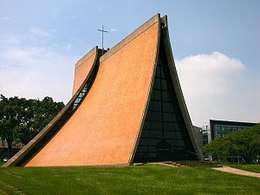Chen Chi-kwan
Chen Chi-kwan (Chinese: 陳其寬; 1921–2007) was a Taiwanese artist and architect, known in particular for his work for Tunghai University.[1] He collaborated with I.M. Pei to design the Luce Memorial Chapel on the university campus – a hallmark of mid-century modernist architecture, which was completed in 1963.[2]
Chen Chi-kwan 陳其寬 | |
|---|---|
| Born | 1921 |
| Died | 2007 (age 85–86) |
| Nationality | Republic of China |
| Alma mater | National Central University University of California, Los Angeles Harvard University |
| Occupation | Architect |
| Awards | National Award for Arts |
| Buildings | Luce Memorial Chapel |

Biography
Born in 1921 in Beijing, Chen's youth was strongly affected by China's War of Resistance against Japan. In 1944, he served as an interpreter in the China-Burma-India Theater of World War II. In 1948, after the war, he started studying architecture in the United States.[3]
In 1951 Chen started working for Walter Gropius, who recommended him as a part-time teacher at the Massachusetts Institute of Technology. He returned to settle in Taiwan in 1960, where he set up the Department of Architecture at Tunghai University.[3]
In 2004, Chen was one of the recipients of Taiwan's prestigious National Award for Arts. Judges said the "decorative colors, architectural lines and mystical spaces" in his paintings "inspired us to see our surroundings in a new light."[4] To commemorate the 90th anniversary of his birth, a selection of Chen's paintings were displayed at the National Palace Museum in Taipei.[5]
In 2007 an asteroid, 236851 Chenchikwan, was named in honour of Chen by its discoverers, C.S. Lin and Q.Z. Ye.[6]
Key dates
- 1921, born in Beijing.
- 1933, junior high school – enrolled in Nanjing secondary school, Zhenjiang secondary school.
- 1937, high school – enrolled in Zhongnan Middle School, National II.
- 1944, graduated from the National Central University Department of Architecture (now the Southeast University School of Architecture).
- 1946, he served as the designer of Nanjing Jitai Architects.
- 1948, went to the United States Illinois State University for further study, a year master's degree in architecture.
- 1950, enrolled at the University of California, Los Angeles, Department of Art.
- 1951, entered Harvard University Institute of Architecture under Walter Gropius, and joined Gropius' architectural practice.
- 1952, taught at Massachusetts Institute of Technology.
- 1954, in collaboration with I. M. Pei, co-designed Tunghai University campus, Taiwan.
- 1960, served as director of the Department of Architecture at Tunghai University.
- 1969, planned the overall design of the campus of the National Central University in Chungli.
- 1980, appointed Dean of Engineering at Ren Donghai University.
- 2007, died in San Francisco, at the age of eighty-six years.
References
- Michael Sullivan (3 April 2006). Modern Chinese Artists: A Biographical Dictionary. University of California Press. pp. 16–. ISBN 978-0-520-24449-8.
- "Renovation project on Tunghai University's iconic church launched | Culture | FOCUS TAIWAN - CNA ENGLISH NEWS". Focustaiwan.tw. 2015-01-16. Retrieved 2017-06-01.
- "Chen Chi-kwan, The Mind's Eye- Commemorating the 90th Anniversary of His Birth". Culture.teldap.tw. 2004-09-03. Retrieved 2017-06-01.
- "Taipei event remembers prominent artist Chen Chi-kwan | Culture | FOCUS TAIWAN - CNA ENGLISH NEWS". Focustaiwan.tw. 2015-01-01. Retrieved 2017-06-01.
- "Chen Chi-kwan, The Mind's Eye: Commemorating the 90th Anniversary of His Birth_Selections". Npm.gov.tw. 2009-06-02. Retrieved 2017-06-01.
- Alan Chamberlin. "JPL Small-Body Database Browser". Ssd.jpl.nasa.gov. Retrieved 2017-06-02.